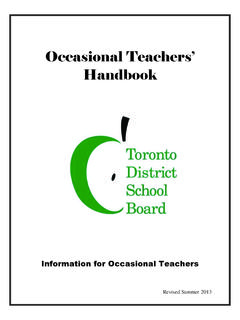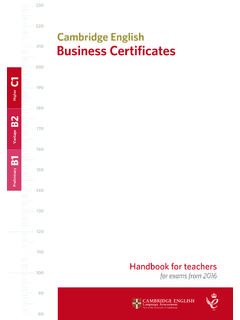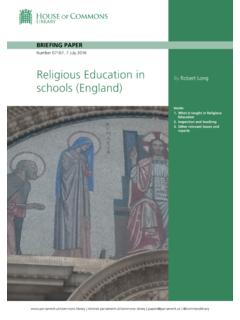Transcription of TABLE OF CONTENTS - Joseph A. Gregori High School
1 TABLE OF CONTENTS Manuscript 1 Title Page 2 Margins and 3 3-4 MLA-Style 5-22 Works 5 Sample Works Cited/Bibliography 6-16 6 Sacred Works, 7-8 Encyclopedias, Dictionaries, 8 Magazines, Editorials, Reviews, Journals, 9 Cross References, Pamphlets, Films, TV/Radio 10 Letters, Interviews, Works of 11 Music, Recordings, 12 Electronic Data 13-15 Teacher/Librarian 16 Parenthetical 17-22 Author/Page (In-text) 17-19 20-22 The Research 23-27 Research 23 Source 24 Note 25-27 28-41 28-32 Tips and 33-39 Correction 40 Correction 41 Study 42-46 42-44 Note 45-46 47 This handbook was designed as a writing tool for students by the high School English departments of Modesto City Schools.
2 Because the English departments defer to the authority of the Modern Language Association and the American Psychological Association in establishing guidelines, many of the examples contained in this document have been borrowed directly from the MLA and APA handbooks. Others are from works on our library shelves; still others are fictitious examples built on non-existent works provided to clarify the rules of documentation. ii 1 MANUSCRIPT FORMGENERAL GUIDELINES Follow these guidelines to ensure that your compositions meet the proper standards: Type or write neatly in blue or black ink. Type or write on only one side of the paper. Preserve one-inch margins on all sides (except for pagination). When using binder paper, establish the left-hand margin at the printed vertical line and preserve a one-inch margin on the right.
3 If you must split a word at the end of a line, consult a dictionary for proper syllable breaks. Double-space the entire manuscript including heading, title, body, works cited, etc. Do not increase spacing between heading and title, between paragraphs, or between any other sections unless instructed to do so. When writing on binder paper, double-space by skipping every other line. Use a standard, twelve-point font throughout the manuscript. When writing on binder paper, concentrate on neatness and legibility. Use upper and lowercase letters; do not type or write in all capital letters. Use proper heading and pagination. Heading: One inch down from the top left-hand margin, write your name, the instructor's name, the course title, and the date (day month year).
4 Pagination: On every page, write your last name and the page number one-half inch down from the top right-hand margin. Center the title. Use proper form when citing quotations. Document all sources properly. Proofread and polish rough drafts. Submit a clean final draft, free of cross-outs. Unless otherwise instructed, do not place your compositions in a cover or folder. Unless otherwise instructed, turn in all elements of the composition process including prewriting activities, rough draft(s), peer response, and final draft. Organize these components in the order specified by your instructor. Staple pages together in the upper left-hand corner before coming to class. The instructions in this handbook are based on the guidelines set by MLA and followed by most colleges and universities.
5 Please keep in mind that some teachers may have additional and/or different requirements depending on the assignment. 2 TITLE PAGE, MARGINS & PAGINATION Standard heading and pagination include the components listed below. MLA requires no additional title page, but individual instructors may have other requirements. " 1" Student's Last Name + Page # Student's Name 1" Teacher's Name Course Title Date (Day Month Year) Title (Centered) The following is an example of the first page of a manuscript.
6 " 1" Martinez 1 1" Juan Martinez Mrs. Carpenter English 7 10 September 2002 An Analysis of Macbeth The witches ominous declaration, Fair is foul, and foul is fair, 1" (I. i. 11) introduces the motif of appearance versus reality in Shakespeare s 1" tragedy Macbeth. From the very first scene, it is clear that the nature of Pagination refers to the method of numbering pages. Type or write your last name before each page number in the upper right-hand corner one-half inch down from the top margin. Below is an example of page 2 of an essay.
7 " Martinez 2 1" when Hecate laughs, "And you all know security/ Is mortals' chiefest 1" enemy" ( ). The weird sisters then raise three "fair" apparitions. PLAGIARISM (Improper use of another person's ideas or language.) Plagiarism is a serious scholarly offense. In the Fifth Edition of The MLA Handbook for Writers of Research Papers, Garibaldi notes that the word "plagiarism" is derived from the Latin word for "kidnapper." Plagiarism is "intellectual theft." It is using "another person's ideas or expressions in your writing without acknowledging the source" (30). Plagiarism is cheating, and in the event that plagiarism is discovered, instructors will impose the penalties outlined in the Modesto City Schools Student Code of Conduct.
8 Students are often confused about what constitutes plagiarism. If you use a familiar expression such as "The Golden Rule," or if you refer to facts that are common knowledge such as "The United States is comprised of fifty states," you need not cite a source. This type of information is considered part of the public domain; however, if you report that the population of Modesto is 175,392, you need to cite your source, as most residents are not aware of the exact number, and population is in flux. Some forms of plagiarism are obvious. If you download a paper from the Internet, or if you cut and paste from several sources, you are guilty of plagiarism. If you copy the paper, ideas, or words of a friend, you are guilty of plagiarism. If you submit work that has been written, revised, or edited--in part or in whole--by another person, you are committing plagiarism.
9 You can also plagiarize yourself. If you submit a paper that you wrote for one class for credit in another class, you are guilty of plagiarism. Likewise, if you steal an idea from a book, movie, speech, magazine, lecture, journal, teleplay, or electronic source and represent it as an original thought--even if it is expressed in your own words--then you have committed an act of plagiarism. A reader has a right to know which ideas are yours and which belong to others, and to know where to find the information you have used. Study the examples on the following page to differentiate between proper and improper use of source materials. AVOIDING PLAGIARISM IN A SUMMARY OR PARAPHRASE Original Version: Hughes, Robert. The Fatal Shore. New York: Knopf, 1987.
10 England attempted to solve its crime problem by transporting criminals to Australia; however, transportation did not stop crime in England or even slow it 3 4 down. The "criminal class" was not eliminated by transportation, and could not be, because transportation did not deal with the causes of crime. (168) Version A: Transportation did not stop crime in England or even slow it down. Criminals were not eliminated because transportation did not deal with the causes of crime. Version A is plagiarized. The writer gives no indication that the words and ideas belong to Hughes. She has attempted to cover her theft by changing or omitting an occasional word. Version B: Robert Hughes points out that transportation did not stop crime in England or even slow it down.



![4173 7Y07 IELTShbk body [prf5] - IELTS Exam](/cache/preview/b/8/c/8/a/2/e/3/thumb-b8c8a2e3db809084f54cadd9ec36d575.jpg)



